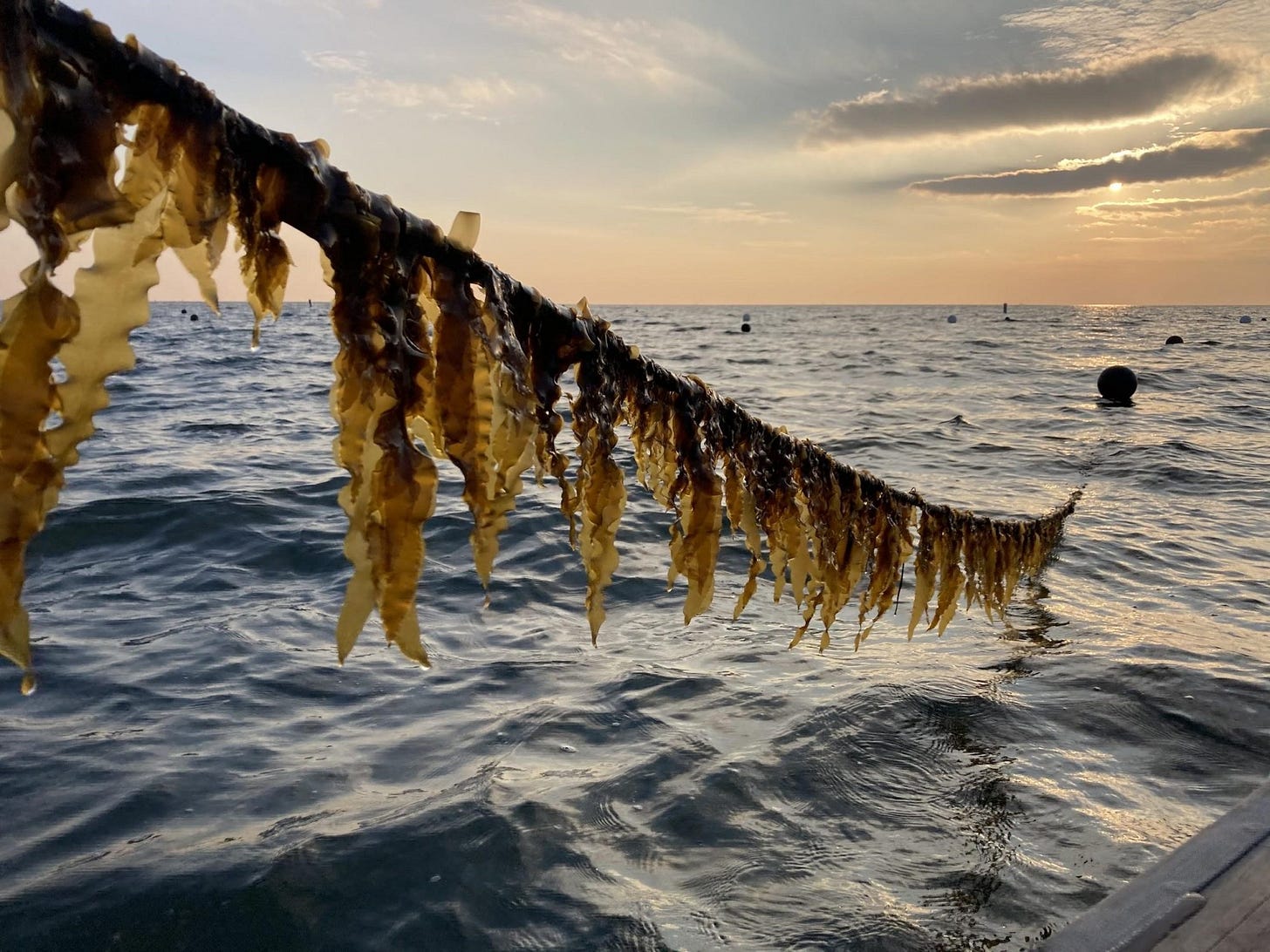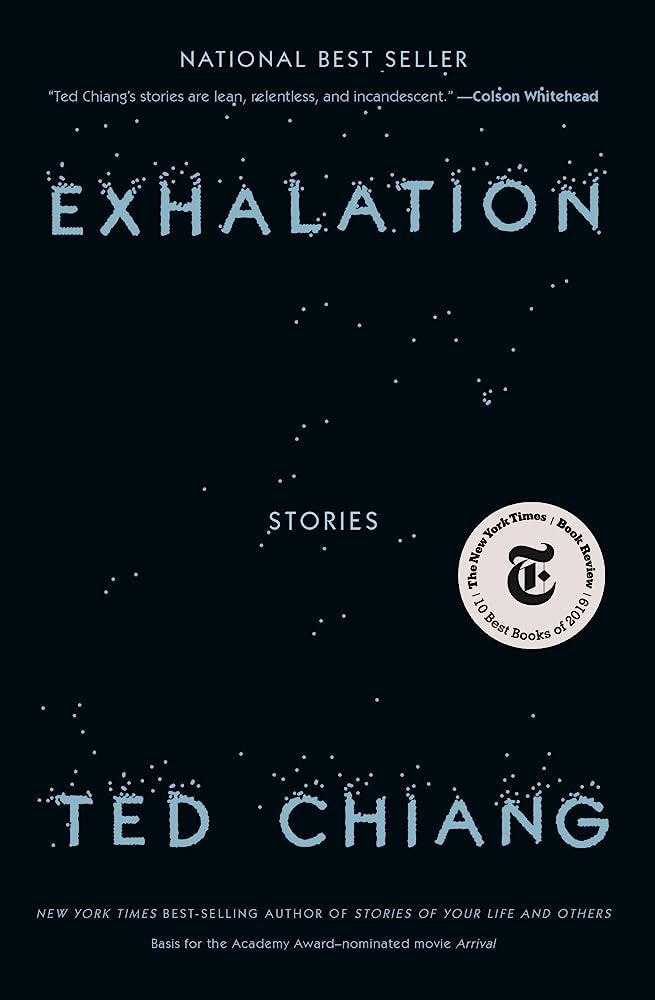BRB w/ Nathan P – Seaforestation, Grilled Beefsteak Tomato & The Exhalation
How kelp can sequester carbon and save the oceans, garlicky flavor bombs from Ottolenghi, and a sci-fi read on bioethics and human's place in the universe (#37).
Hi all,
Welcome back to BRB w/ Nathan P, your 5-min weekly dose of climate information to inspire climate action.
My mission is to make it fun, easy, and delicious to make more sustainable decisions.
Each Wednesday, I share 💥1 Breakthrough, 🥘1 Recipe, and 📚1 Book on food & climate.
💥 Breakthrough: Seaforestation
We can thank the oceans for every other breath we take.
The oceans produce 50% of the oxygen in the atmosphere, and can also sequester carbon faster and in a more durable way than on land.
Carbon cycles relatively quickly on land, captured by plants and eventually released when leaves and wood decompose.
To sequester carbon more long-term, forests either need to remain untouched or regenerative practices need to remain active. The lack of one or both is why we see so many fraudulent carbon credit schemes.
The oceans, however, act as “carbon conveyor belts.” When seaweed die, the carbon they captured sinks to the ocean depths where it can remain for millennia.
Kelp in the oceans can also sequester carbon faster than the lushest parts of the Amazon. In Monterey Bay, kelp can grow two feet in length each day.
Kelp are vital to wide variety of marine life, but they are in danger. Two recent phenomena have decimated kelp populations on the Californian cost:
In the late 19th century, agricultural run-off started causing algal blooms that wiped out kelp.
In the past decade, warmer currents and declining otter populations deprived kelp of nutrients and caused sea urchins populations to spike. Urchins consume lots of kelp. A great reason to have more uni on your next sushi outing, if you ask me.
There are limited natural habitats where kelp naturally form, as they need:
🪨 Shallow, rocky bottoms for attachment
🌊 Cool and nutrient-rich waters
☀️ Plenty of sunlight
There are only so many areas where kelp can regenerate. But with human intervention, we can recreate these environments with underwater rafts in a process called seaforestation: the combination of “sea” and “afforestation.”
Seaforestation has been used in Japan for centuries to cultivate seaweed, and can be deployed at scale with impressive results.
One attractive site for seaforestation is river outlets, where excess nitrogen and phosphorus from agriculture often cause “Dead Zones.”
In these “Dead Zones,” uncontrolled algal blooms feed off the nutrients and use up all the oxygen, suffocating other marine life. The “Dead Zone” in the Gulf of Mexico is about the size of the state of Connecticut.
Kelp can instead be grown on submerged platforms, using the nutrients to grow and producing oxygen during the day to reduce “Dead Zones.” They can then play a central role in setting up marine polycultures, where kelp can be cultivated symbiotically with scallops, oysters, and mussels.
Seaforestation is a win for marine ecosystems and seafood lovers. It can also bring more kelp-derived products to market:
🍔 Food, like seaweed salads and kelp burgers
🧴 Cosmetic products, like facial creams
🌾 Fertilizer and biostimulants for agriculture
Seaforestation has a plethora of benefits: it can help us restore marine ecosystems, sequester gigatons of carbon, and supply more protein. Researchers estimate that seaforesting 4-9% of the world’s oceans could meet the protein needs of the anticipated 10 billion people on Earth by 2050.
The benefits of seaforestation keep cascading. Kelp can help fish populations rebound, as fish need places to hide from predators. And they can also revive coral reefs, by pumping up cold water upwards to counter heatwaves that have already affected half of the world’s corals.
It will take massive investment and collaboration to achieve seaforestation at scale. It is one of the next frontiers in cultivation and preservation – and perhaps our oceans’ best hope.
🥘 Recipe: Grilled Beefsteak Tomatoes
If you like heirloom tomatoes, this recipe transforms them into flavor bombs.
Ottolenghi’s grilled beefsteak tomatoes with garlic and ginger is a dinner party crowd-pleaser, which I paired here with balsamic glazed burrata and blistered grapes.
If you are hosting soon and want to impress your next guests, scroll down for the recipe.
If you make it, please send pictures :)
📚 Book: The Exhalation
Ted Chiang is one of my favorite science fiction writers. I rewatched the movie Arrival last week, which is inspired by one of his stories.
The Exhalation is another anthology of short stories on bioethics, robots & AI, and the place of humans in the universe.
The first short story, “The Merchant and the Alchemist’s Gate,” is such a beautiful and poignant tale.
Chiang’s eloquent prose whisks us to a market in the Middle East, where an alchemist allows passerby to walk through a gate from seconds to years in the future. I was blown away by the inherent connections it reveals between our past and future selves, between character
Other stories reimagine the relationships between humans and other animals, explore what human-built robots reveal about ourselves, and urge an existential revision of what sustains life on this planet. Lots of food for thought – hope you enjoy it.
Some favorite quotes:
Nothing erases the past. There is repentance, there is atonement, and there is forgiveness. That is all, but that is enough.
Past and future are the same, and we cannot change either, only know them more fully.
Humans have lived alongside parrots for thousands of years, and only recently have they considered the possibility that we might be intelligent. I suppose I can’t blame them. We parrots used to think humans weren’t very bright. It’s hard to make sense of behavior that’s so different from your own.
Some humans theorize that intelligent species go extinct before they can expand into outer space. If they're correct, then the hush of the night sky is the silence of the graveyard.
Thank you for reading – BRB next week ✌️
🥘 Recipe: Grilled Beefsteak Tomatoes
Adapted from Yotam Ottolenghi in Simple
Ingredients (makes 4 servings):
75ml olive oil
2 cups or ~20 grapes
1/4 cup balsamic vinegar
1/4 cup red wine vinegar
8 garlic cloves
4cm piece of ginger
20g coriander leaves
1kg beef tomatoes
3g thyme
flaked sea salt and black pepper
Instructions:
Rinse the grapes and marinate them in the balsamic vinegar, red wine vinegar, and thyme overnight.
Preheat oven to its highest grill setting.
Pour the oil into a saucepan and place on a medium high heat. Add the sliced garlic and ginger and fry gently for 5 minutes, stirring every once in a while until the garlic is just starting to brown.
Add the coriander stalks and continue to fry for 2-3 more minutes, until the garlic is a light golden brown and the chilli is aromatic. Using a slotted spoon (to preserve the oil), transfer the aromatics to a plate to stop them cooking. Set aside.
Arrange the tomato slices on a 30 x 40 cm baking tray, so they are not overlapping. Brush with 2 tbsp of the aromatic oil, then sprinkle with 1 1/2 tsp of flaked salt and a generous grind of pepper.
Place the tray about 5 cm beneath the grill and cook for 10-12 minutes, until the tomatoes have started to brown. Remove the tomatoes from the oven, pour over the remaining aromatic oil, sprinkle over aromatics and set aside for 10 minutes.
Skewer the marinated grapes. On medium-high heat, place the grapes for a few minutes, rotating until blistered on each side.
To serve, place the ball of burrata on a plate with the skewers of blistered grapes. Serve the tomatoes at room temperature on the side, overlapping them slightly.
Scatter over the coriander leaves and pour over any oil and juices remaining onto the tomatoes and burrata. Don’t forget the bread :)
About Me
Hi there! My name is Nathan Paumier – I’m an avid reader, food enthusiast, and climate optimist. I started this newsletter after frequent questions on food tech, reading recommendations, and my secret recipes.
Want to get in touch or chat further? Anything you’d like to hear more of?
Forwarded this email?
Subscribe below to receive an email from me every week.
No spam, just quality ingredients.










